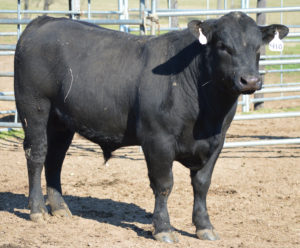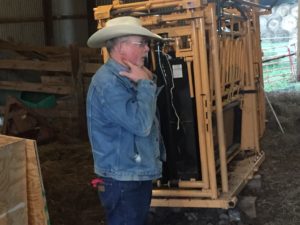Staying Safe Around Beef Cattle
In part seven of our “What’s Your Beef?” series on raising cattle on small farms, we discuss how you must be vigilant about safety when working with cattle.
This is the seventh article in our “What’s Your Beef” series on beef cattle management and focuses on safety considerations when working with beef cattle. The six previous articles can be accessed in the Small Farm Quarterly archives.

Bulls can be dangerous and are never to be trusted!
Rich Taber/ Great Northern Farm
Each year, thousands of people throughout the USA are injured, and a few are killed when around cattle. Beef cows and bulls can be extremely large, heavy animals sometimes weighing upwards of a ton. After a lifetime of working around dairy cattle, beef cattle, and sheep, I have seen my share of accidents with different classes of livestock. Bulls in particular can be extremely dangerous. They can be territorial and may attack you if you disrupt them when they are breeding. Several years ago, a former FFA student of mine was killed by a belligerent Jersey bull. That same year, I was attacked by a young Jersey bull that I was using to breed some dairy heifers. The bull had been fine and acted just like any other animal in the herd. Then one day out of the blue he came after me while I was in the back of an old manure wagon feeding hay. I came out of this unscathed; however, the bull soon left the farm. As a rule, beef bulls are not as dangerous as dairy bulls, but still can never be trusted. Cows with newborn calves can be very aggressive towards humans and you must never turn your back on them. If you’re going out into the pasture to ear tag or check on baby calves, a bawling calf can trigger very hostile reactions from the mama cow, and its best to take someone with you for assistance.
Before we delve further, I am going to suggest that you investigate the docility of the breed of cattle that you are working with. Some breeds are much more docile, and “laid back” if you will. Artificial insemination studs have docility indexes for different breeds; docility can vary between breeds as well as within breeds. I have a crop of calves this year that “go ballistic” when we try to handle them; I will not be retaining any of them for breeding replacements. I will be looking for a different sire breed next ear for my replacement bull. As you get older, dealing with wild, unruly animals gets old quickly! If genetics can help, avail yourself!
I have some information here excerpted from Gempler’s Tailgate Training Tip Sheet #98. “Dangers of Bulls and Other Cattle” and embellished with some of my own experiences.

Mike Baker explains how to safely vaccinate cattle at a Beef Quality Assurance class at the author’s farm, highlighting the cattle squeeze chute.
Rich Taber/ Great Northern Farm
- Often, injuries occur because an animal, such as a cow, appears to be gentle, and the person working with the animal is caught off guard. This is the old “familiarity breeds contempt” concept. I recently read of an animal sanctuary farm taking in a mature bull that for about a year was the hit of the farm, as he let visitors rub his nose and forehead. Then the day came when he maimed and almost killed his handler in a twist of personality.
- Bruises, broken bones, crushed limbs, or even death may occur from falling or getting knocked down or run over by an animal.
- Cattle are unable to see directly behind them, because of that, they can be easily startled. Speak gently and don’t yell or scream at your cattle.
- As mentioned, if a cow has a newborn calf, be sure to keep your distance because the mother will be very protective and avoid walking between the cow and her calf.
- Its critical that you use extreme caution when you are around a bull. I make it a practice of always keeping note of where the bull is when I am out feeding my herd. I have to get off the tractor to peel the remaining net wrap off of the round bales. I try to remove as much plastic outer wrap and net wrap or strings before going into the field. Generally, I can’t cut the net wrap off until I am right at the bale feeder or else the bale will fall apart before I want to deposit it. But the bull’s location is always on my mind!
- This fall has been very aggravating with endless rain and subsequent mud, muck, and sloppy conditions being the norm. I move my feeders every few days to limit the formation of quagmires which are unsafe to work though. You don’t want to be stuck in a quicksand like, boot sucking nightmare that impede your movements around the cattle.
- Never beat your cattle with clubs, sticks, canes, etc. Keep your voice low and make loud noses that can startle animals. NEVER EVER run or chase animals!
- If the cows get out, and people unfamiliar with cattle handling techniques come to help you round them up, instruct them NOT to chase, yell, or run after cattle! I have had better success in rounding up cattle with one or two experienced handlers rather than a bunch of people running around stirring up a disaster!
- Always plan an escape route in case you run into trouble.
- Know that cattle have a “flight zone.” This is the animal’s personal space. When you come within that zone, the animal will move.
- Never mistreat cattle! If you see a co-worker beating or hurting an animal take remedial action!
Beef cattle sooner or later require management activities to occur; this necessitates that the animals be restrained. Castrations, vaccinations, pregnancy checking, artificial insemination, and ear tagging are a few examples. If you’re in the beef business for the long haul, you will need to invest in a handling system. A squeeze chute will be at the top of the list, as well as a corral system to handle the animals. “Bud boxes” have become quite popular in recent years to handle cattle in; they funnel the animals safely into the squeeze chute. Veterinarians will be much more conducive to coming to your place when needed if the animals can be safely restrained.
Temple Grandin is a world-famous teacher and author concerning the safe, humane handling of farm animals. Her knowledge has been influential in retrofitting animal facilities to safer and more humane facilities. Two excellent books that she has authored are “Humane Livestock Handling” and “Working with Farm Animals”.

